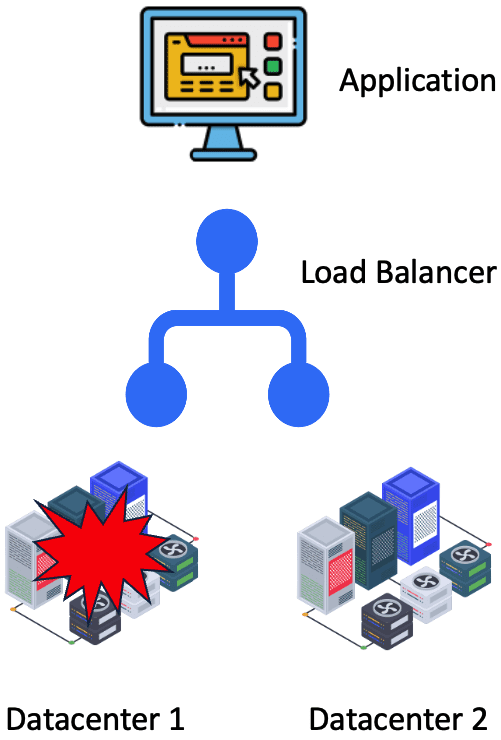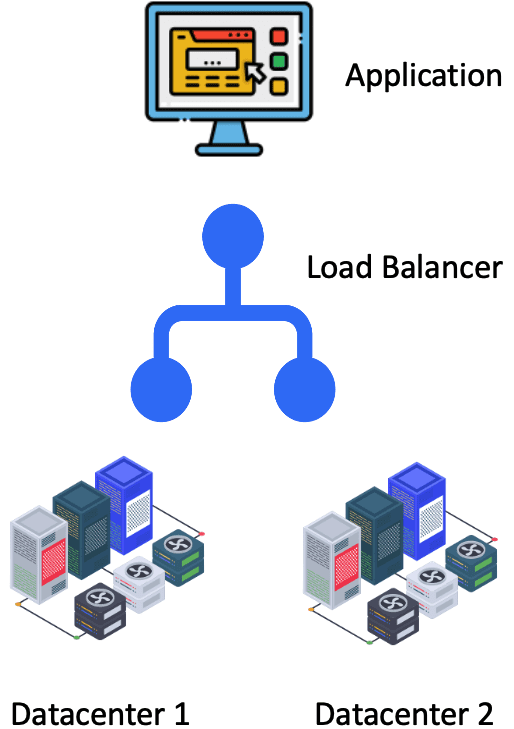The various aspects that contribute to the Application Resilience
Application resiliency relies on components that ensure the uninterrupted functioning, efficiency and accessibility of an application. These components include:
A. Maintaining availability
High availability focuses on ensuring that the application remains operational and accessible, in the face of component failures or disturbances. By implementing redundancy and fault tolerance measures the application can swiftly recover from failures. Minimize any downtime.
B. Ensuring fault tolerance
Fault tolerance involves designing the application to withstand failures without compromising its performance. By incorporating error handling and recovery mechanisms the application can continue to function even if certain components or services experience issues.
C. Developing a disaster recovery plan
Disaster recovery entails establishing strategies and procedures for recovering both the application itself and its data in case of failures or catastrophic events. This includes having systems, off site data storage options well as well defined recovery protocols to mitigate the impact of such situations.
D. Implementing redundancy measures
Redundancy refers to deploying backup resources to maintain operation and minimize any potential downtime. By having servers, databases or other resources in place the application can seamlessly switch to these backups when faced with failures.
E. Utilizing load balancing techniques
Load balancing involves distributing workloads across resources to optimize performance and prevent a point of failure.
By distributing tasks the application can effectively manage increasing demands. Prevent any particular resource from becoming overwhelmed.
F. Scalability
Scalability refers to the ability of an application to handle growing workloads and user demands without affecting its performance. When designing the application it is important to consider scalability so that it can effortlessly accommodate growth and cater to users or resources.
G. Monitoring and alerting
Monitoring and alerting systems play a role in ensuring the resilience of an application. By implementing monitoring systems we can continuously keep track of the applications health and performance. This enables us to promptly identify failures or unusual conditions triggering alerts that require attention and intervention.
H. Automated recovery
An essential aspect of application resilience is incorporating automated mechanisms that can detect failures and initiate recovery actions without intervention. By automating recovery processes we enable the application to respond to failures minimizing downtime and reducing the impact on users.
Cloud Resilience
In today’s paced world it is of utmost importance for applications to be able to withstand any unexpected issues or failures. To ensure the operation of an application it is crucial to take advantage of cloud infrastructure and services in order to enhance its resilience.
Taking Advantage of Cloud Infrastructure
Cloud platforms provide a range of features and capabilities that contribute to the resilience of applications. One such feature is auto scaling, which allows applications to automatically adjust their allocation of resources based on demand. With auto scaling applications can handle increases in traffic without compromising performance or reliability.
Geographic Redundancy
Cloud providers also offer redundancy, which helps ensure that applications remain available in the face of local failures or natural disasters. By spreading application components across multiple regions organizations can minimize the impact of disruptions. Maintain service for their users.
Automated Disaster Recovery
The cloud empowers organizations to implement automated disaster recovery strategies. By replicating application data and services in locations businesses can swiftly restore operations in case of an outage or catastrophic event. Automated disaster recovery ensures downtime. Enables organizations to recover seamlessly.
By utilizing these strategies, for cloud resilience organizations can significantly bolster their applications ability to withstand disruptions and maintain levels of availability.
When you have the appropriate cloud infrastructure and services set up applications can maintain their reliability when faced with obstacles.

Application Resiliency Benefits
The advantages of having applications are significant. Can greatly contribute to a business’s success and customer satisfaction. By implementing measures to ensure application resiliency businesses can enjoy the following benefits:
A. Improved business continuity
With application resiliency, in place businesses can effectively manage challenges without disruptions. Whether its a hardware failure, software issue or cyber attack application resiliency ensures that critical business operations can continue seamlessly.
B. Reduced downtime and financial losses
Application downtime can be highly costly in terms of revenue loss and damage to a business’s reputation. A resilient application is designed to handle failures and quickly recover from any disruptions thereby minimizing the impact on financials.
C. Enhanced Customer satisfaction
Customers have tolerance for unreliable applications. By investing in application resiliency businesses can provide users with an uninterrupted experience leading to increased customer satisfaction.
Not only does this improve customer satisfaction, it also fosters brand loyalty and encourages customers to come back for more.
- Businesses can experience continuity in their operations.
- They can minimize downtime. Avoid losses.
- Users will have an experience leading to customer satisfaction.
By giving priority to the resilience of applications and utilizing technologies businesses can enjoy these advantages and stay ahead of their competitors in today’s digital world.
Best Practices for Application Resilience
Ensuring the resilience of your applications involves following a set of practices. These practices aim to minimize downtime, enhance performance and improve the user experience. By implementing the strategies outlined below you can ensure that your applications can withstand failures.
A. Implementing patterns and technologies
- Embrace Microservices: Breaking down your application into services helps mitigate the impact of failures. Each microservice operates with its resources and can be easily scaled or replaced as needed.
- Harness Containerization: Leveraging container technologies, like Docker provides isolation and resource utilization simplifying deployment and management across environments.
Design Distributed Systems: Structuring your application to span servers enhances redundancy. Fault tolerance. This ensures that your application remains operational even if one or more components encounter issues.
B. Strengthening data availability and recovery mechanisms
Data serves as the lifeblood of any application making it crucial to ensure its availability and recoverability. Consider adopting the following practices:
- Regular Backups: Taking backups of your data assists in recovering from failures or data loss.
- Data Replication: Replicating data, across servers or data centers offers redundancy. Improves availability.
- Monitoring and alerting: It is important to have a system in place for monitoring and alerting. This will help you detect any issues and take proactive steps to ensure that your data remains accessible.
C. Utilizing automation, for fault detection and recovery
Automation is key when it comes to ensuring the resilience of your applications. By automating the processes of detecting faults and recovering from them you can minimize the impact of failures. Reduce downtime. Here are some recommended automation practices:
- Automated monitoring: Make use of monitoring tools that continuously keep track of the health and performance of your application. Set up alerts so that you can be notified promptly about any issues.
- Automated scaling: Implement mechanisms that allow resources to be automatically adjusted based on the demands placed on your application. This will help maintain performance during varying workloads.
- Automated recovery: Establish automated recovery processes that can quickly recover from failures or trigger failover mechanisms without requiring intervention.
D. Aligning application resilience with business goals and priorities
It is crucial to align your efforts in achieving application resilience with the goals and priorities of your business. Consider implementing these practices to ensure that your resiliency measures are focused on what matters:
- Risk assessment: Conduct an evaluation of risks identifying possible failures and assessing their impact on business operations.
- Business continuity planning: Develop a plan outlining the steps to be taken in case of failures or disruptions.
- Regularly conduct testing: Make updates to ensure that your applications resilience mechanisms can effectively adapt to evolving business needs and technological advancements.
Conclusion and Future Outlook
As we wrap up our exploration of application resiliency lets recap the points we’ve discussed.
A. Summary of takeaways
- Application resiliency refers to an applications ability to withstand failures and recover ensuring functionality and a seamless user experience.
- It is crucial to understand the components of application resiliency, such as redundancy fault tolerance and disaster recovery in order to build resilient applications.
- Leveraging the scalability and availability of cloud computing infrastructure enhances application resiliency through cloud resilience.
- The benefits of application resiliency go beyond minimizing downtime and financial losses; it also improves customer satisfaction, brand reputation and overall business resilience.
- Implementing practices like failure testing, monitoring and automation significantly enhances application resiliency.
Looking ahead it is important to consider the emerging trends and advances that will shape the future of application resiliency.
B. Emerging trends and advances in application resiliency
One notable trend in application resiliency is the growing adoption of microservices architectures. By breaking down applications into independent services organizations can achieve resilience by isolating failures and reducing their impact on the entire system.
Another significant advancement involves harnessing intelligence (AI) and machine learning (ML) for enhancing application resiliency.These technologies provide the ability to monitor proactively analyze predictions and recover automatically. This enhances the capability to detect and respond to failures before they impact the application.
Moreover the emergence of serverless computing and edge computing presents opportunities for improving application resilience. Serverless architectures, with their event driven nature and automatic scalability effectively distribute workloads. Reduce the risk of failures in areas. On the hand edge computing allows processing and data storage to users minimizing delays and enhancing resilience in situations with limited network connectivity.
As organizations continue to prioritize application resilience we can anticipate progress in areas such as containerization orchestration and advanced monitoring tools. These technologies will empower businesses to construct applications that can withstand the demands of modern digital ecosystems.
In conclusion, application resilience plays a role in ensuring stability and availability for today’s applications. By comprehending its components, implementing practices and staying informed about emerging trends organizations can safeguard their applications for challenges while providing uninterrupted experiences for users.
FAQs
What exactly is application resiliency, and why is it important?
Application resiliency means that your application has the ability to quickly adapt and recover from issues, such as hardware failures, software errors, or even cyberattacks. This is crucial because downtime and disruptions can lead to lost revenue, damage to your brand’s reputation, and frustrated customers. A resilient application minimizes those risks and keeps your business operations running smoothly.
How can I make my applications more resilient?
There are several key strategies to bolster application resiliency. These include:
- Redundancy: Have multiple copies of critical components (servers, databases) to ensure continued operation if one fails.
- Fault tolerance: Design your application to gracefully handle errors and continue functioning even when parts of it aren’t working correctly.
- Disaster recovery: Have a well-defined plan for recovering your application and its data in case of a major outage.
Cloud-based resilience: Solutions like Trilio Vault offer cloud-native data protection and recovery, ensuring your application data is secure and easily recoverable across cloud environments.
What role does the cloud play in application resiliency?
The cloud offers significant advantages for enhancing application resiliency. Features like auto-scaling, geographic redundancy, and automated disaster recovery provided by cloud platforms are powerful tools. Cloud providers ensure that your applications remain available and accessible even during unexpected events. Trilio Vault, in particular, specializes in cloud-native backup and recovery for applications, simplifying the process of securing and restoring your critical data.





